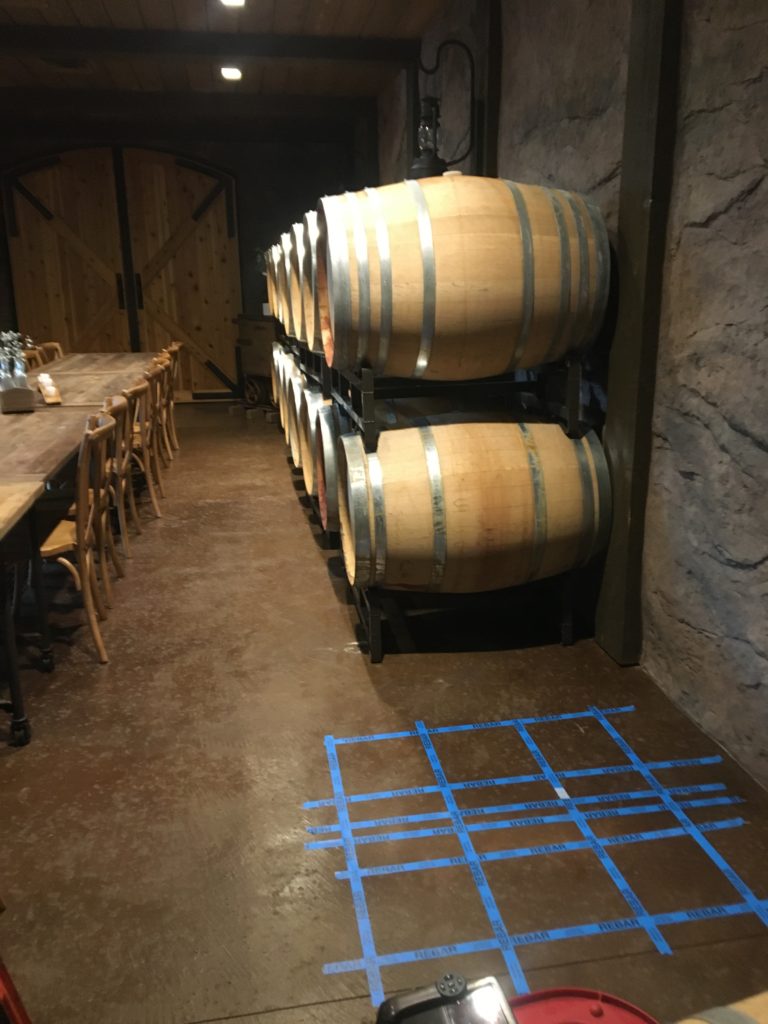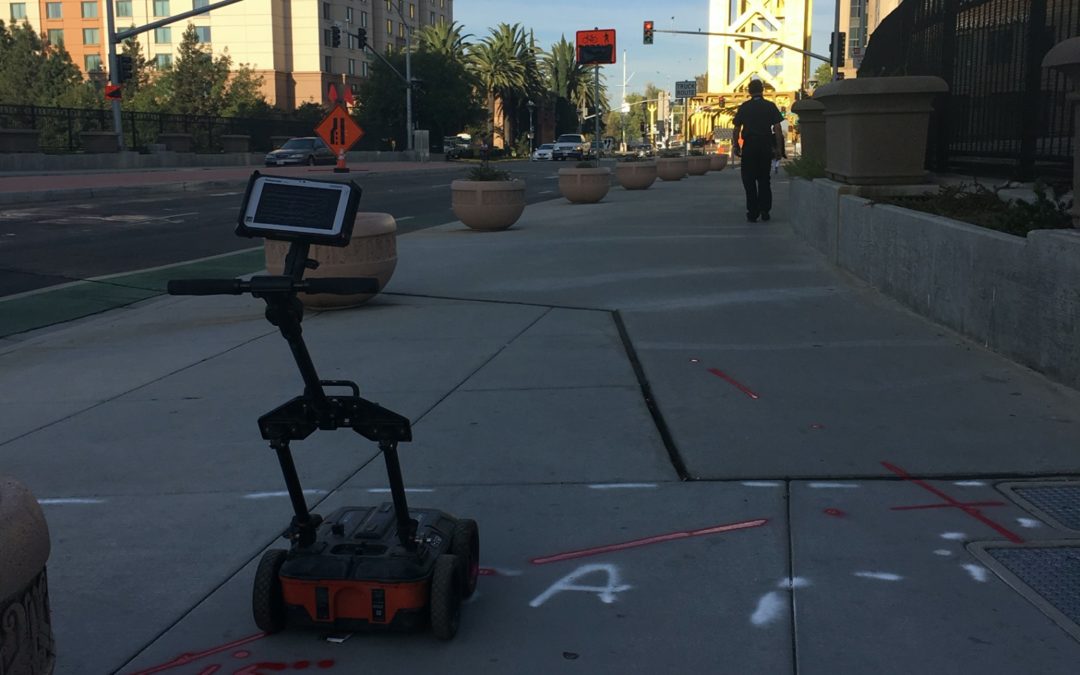What Is Concrete Scanning And What Can It Find?
Concrete scanning is a non-destructive concrete assessment method which uses ground penetrating radar, or GPR, to evaluate the integrity of the structure in place and locate embedded utilities prior to concrete cutting, coring, drilling, etc. Because GPR uses reflected radio waves, this concrete imaging method is safe, non-invasive and more effective and versatile than X-ray for concrete assessment of columns, slabs and walls.

Concrete scan technology including ground-penetrating radar (GPR) can be used in a wide range of situations and for needs including:
- Subsurface utility engineering
- Underground utility locating
- Private utility locating
- Utility location within existing concrete
- Preconstruction utility mapping
- Planning and preparing for CCTV, video or other pipe inspections
- Safety hazard recognition, marking and avoidance
- And others.
Scanning can and should be used on nearly any concrete surface, especially before any cut or drill operations, including:
- Slab on grade
- Columns
- Decks
- Floors
- Walls
- Roadways
- Sidewalks
- Encasements
- Tunnels
- And more.
A GPR scan can aid in locating embedded objects within concrete slabs and other structures, such as:
- Rebar or other reinforcing steel members
- Electrical conduits
- Gas pipes
- Water lines
- PVC conduits of all sorts
- Post tension cables
- Leak detection
- Hidden objects
- And more!
Why is concrete scanning important?
Ground penetrating radar is vital to the safety of personnel and the success of both new and existing concrete construction, utility placement, traffic control and underground utility repair, just to name a few. GPR scans detect embedded electrical conduits, rebar, cables and other hazards which would otherwise be undetectable. Cutting or damaging these objects can undermine the strength and performance of the concrete, cause expensive damage to utilities and/or jeopardize the health and safety of workers and the general public.
Even better, ground penetrating radar scan data can give your leadership team more information, more quickly and more safely than X-ray, allowing you to more readily plan for CCTV pipe inspection, remediation, invasive testing and repairs such as pipe vacuum excavation and slab cutting, coring and drilling operations.
How do I know if we need a concrete scanner on my construction job?
If your project involves existing concrete with structural or utility elements, such as preexisting concrete floors, you definitely need to plan for GPR on the site. If you’re planning subsurface utility engineering, installation, video pipe inspection or repairs, you should have GPR onsite to help you avoid any unpleasant surprises such as unknown or unmarked utilities, which is an especially frequent risk in areas with older construction.
How much does your company charge for concrete GPR scanning for my project?
Every project is different. A relatively quick scan of a single-home foundation slab on grade will take a lot less time and be less expensive than a walkthrough of a two-floor industrial building with concrete columns, walls and decks which must all be addressed. That said, it will always be a lot cheaper to scan concrete beforehand than it is to repair damages caused by incautious cutting! If you’d like to request an estimate, we encourage you to click here to contact us!
Is GPR concrete scanning safe?
You probably already know this, but radio waves pass around and through us and everything we see and touch every moment of the day! Radar works on the principle that certain materials, such as dense metals, will reflect radio waves back in a predictable manner. It is this property of radio waves which allows GPR to pick up structural reinforcing members, electrical conduits, gas and plumbing lines sheathed in PVC and so on. Unlike X-ray concrete scanners which use radioactive materials and require complete test area shutdown, there are no known risks to bystander health associated with ground penetrating radar. Most of the dangers which do exist result from improperly using or carrying the concrete scanner, which a technician with experience and proper training will take care to avoid.
Can GPR deliver real-time thermal imaging?
Depending on the type of scanner being used, the image on the screen may look a lot like the readout from a thermal imaging display, but it’s not the same. Unlike thermal imaging which registers relative heat signatures and displays them as a gradient, GPR registers relative densities of materials. This means a hot electrical conduit or water line will only show up as a material of medium density, as compared to the reinforcing steel which usually shows up as a regular or semi-regular grid pattern. We use existing drawings and construction as-built documentation in conjunction with the readings to work out exactly what we’re seeing at a given location.
Where does Safe2Core offer its concrete scanning services?
With locations in Florida, Texas, Arizona and both southern and northern California, Safe2Core locations offer great coverage for a large portion of the continental US. To contact us about location and concrete scanning services, click here!
Frequently Asked Questions about Concrete Scanning
Question: Does GPR concrete scanning work? –Amir, Miami, FL
Answer: In most cases, concrete scanning using GPR is the fastest, most effective and efficient way to determine the presence of utilities and embedded structural members, making them easy to avoid. In some very unusual cases, GPR may not be exactly the right option for obtaining proper scanning. When this is the case, we can deploy the option best suited to your site’s unique characteristics and requirements.
Question: What factors can impact the results of concrete scanning using GPR? –Deborah, Bullhead City, AZ
Answer: Concrete scanning is not a particularly delicate operation, but certain conditions can interfere with proper readings. These include:
- Slab thickness
- Steel content
- The original concrete mix design
- Soil and subgrade conditions beneath the slab
- Interference from other sources
While these are not especially common to encounter when dealing with modern construction techniques and documentation practices, these issues can and do crop up from time to time. We will evaluate your site based on known information and match the right scanning technology to the prevailing conditions at the site.
Question: How long does GPR take to detect a utility? –Chennowith, Anaheim, CA
Assuming no interference or unusual site conditions, GPR can detect embedded structures very quickly, often as fast as a few seconds. Because the GPR can only identify density and relative position of embedded structures, we can only get a full picture of the area once the scan is complete and we’ve matched the findings to the construction documentation. With this approach, we offer pinpoint accuracy, but it does take a little time to ensure we’re matching what the site documents show to what’s actually there.
Question: Can GPR scanning identify and differentiate between rebar, posttension cables, electrical conduits and other embedded materials? –Roderick, Oakland, CA
Answer: In itself, no. GPR can say “something” is at a given location, and what the relative density of that “something” is. Accurately interpreting the information into usable utility and other material marking is as much art as it is science, and requires a human mind and eyes to equate “this” signature to “that” specific material. Because our technicians are seasoned professionals with ample training and experience, they can usually render reasonable guesses, but we prefer to refrain from doing so until we have the big picture and can evaluate it properly.
Question: Can you locate electrical conduits made of PVC? –Luci, San Antonio, TX
Answer: Technically, yes. PVC will show up as a medium-density obstruction with slightly higher absorption than reflection to the radar signal, unlike metal which gives a very robust reflection and minimal absorption. However, simply seeing a medium-density object is not enough, by itself, to say, “This is an electrical conduit sheathed with PVC.” All we can say with certainty in that situation is that something which may be PVC is present until we reconcile the GPR scanner return with the site drawings.
Question: Do your concrete scanner technicians have experience? –Carroll, Phoenix, AZ
Answer: Yes. Our technicians go through rigorous operation and safety training and certification. When one of our techs is onsite, you can rest assured you will get the answers you need as soon as possible, with no worries about whether the job will be done right.
Question: Is GPR safe to be around? –Scott, Cucamonga, CA
Answer: Yes. GPR uses radio waves in the same way submarines, dolphins, whales and bats use sound waves to navigate, which we call sonar. Radio waves pass through everything, from the screen you’re reading this on to the planet which sustains our lives. Unlike X-ray and other types of radiation, radio signals have never been shown to be harmful to humans, so being near a GPR scanner poses no danger to you, your crew or our technician, which makes it a better choice all the way around for your concrete scanning needs!





